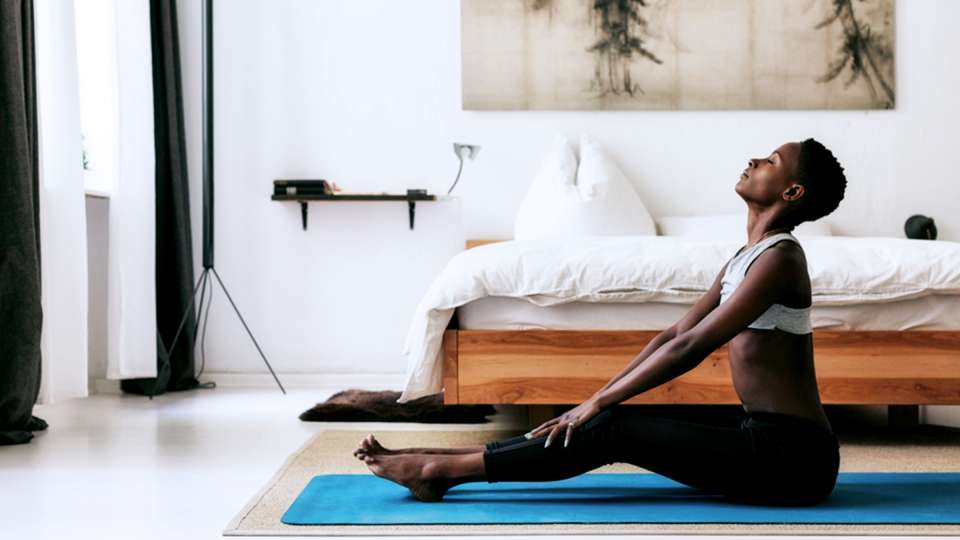
You probably don’t think about your breath that often. It’s always there, in the background, when you need it.
But paying more attention to how you’re breathing can make a big impact on your stress levels.
“When you’re stressed or anxious, your breathing tends to be irregular and shallow,” says Kristoffer Rhoads, a clinical neuropsychologist who treats patients at the UW Medicine Memory & Brain Wellness Center at Harborview Medical Center. “Your chest cavity can only expand and contract so much, which makes it hard to get more air in.”
Deep breathing (sometimes called diaphragmatic breathing) is a practice that enables more air to flow into your body and can help calm your nerves, reducing stress and anxiety. It can also help you improve your attention span and lower pain levels.
Ready to give it a try?
How deep breathing calms the body — and mind
Your breath isn’t just part of your body’s stress response, it’s key to it. In fact, you can induce a state of anxiety or panic in someone just by having them take shallow, short breaths from their chest, Rhoads says. (You’ve probably heard of this as hyperventilation.)
That means that purposeful deep breathing can physically calm your body down if you’re feeling stressed or anxious. It can be helpful for dealing with day-to-day anxiety as well as more pervasive problems such as generalized anxiety disorder.
But why does deep breathing work? It has to do with how your nervous system functions.
Here’s a quick and painless biology lesson: Your autonomic nervous system, which controls involuntary actions like heart rate and digestion, is split into two parts. One part, the sympathetic nervous system, controls your fight-or-flight response. The other part, the parasympathetic nervous system, controls your rest-and-relax response.
While both parts of your nervous system are always active, deep breathing can help quiet your sympathetic nervous system and therefore reduce feelings of stress or anxiety.
“It is not possible to turn the sympathetic nervous system off completely, but I think of shifting one’s breathing to a modulated, slow, relaxed pattern of not overly deep inhales and exhales as a way to turn the volume down on it,” Rhoads explains.
How to practice deep breathing
Deep breathing instead involves taking slower, longer breaths from your stomach to counter the short, rapid breaths that you default to when stressed or anxious.
Rhoads likes to teach deep breathing by first having someone activate their sympathetic nervous system. You can do this by sitting comfortably, closing your eyes and imagining an extremely stressful situation. Notice how your body responds: Your chest might tighten, your breathing might grow shallower and your heart might beat faster.
Next, turn your attention to your breath. Focus on breathing from your stomach, pushing your stomach out each time you inhale. Take longer breaths, counting to at least three for each inhalation and exhalation. Keep doing this even though it may feel uncomfortable at first. After a while, you will start to notice your body feeling more relaxed.
“Noticing the differences for yourself in how your body feels is more powerful than anyone describing it to you,” Rhoads says.
Deep breathing may be simple, but it isn’t necessarily easy. It can quiet your nervous system in a short amount of time, though it probably won’t provide instant relief from all anxiety. The more you practice, the better you’ll get at it and the more you’ll be able to use it in times of stress to help calm yourself down.
Deep breathing exercises for anxiety
Here are some ways to up your deep breathing game.
Try different breathing patterns
There are many ways to breathe deeply, so play around to find one that feels natural to you.
Try breathing in for four counts, then out for six. Or try square breathing: in for four, hold for four, out for four, hold for four.
As long as you’re still keeping your breathing slow and deep, there’s no pattern that’s better than the others.
Practice self-compassion
Be kind to yourself as you practice deep breathing. Recognize that you might not notice results immediately, and that’s OK.
Give yourself credit for trying, and keep practicing, even just for a minute or two at a time, until you reach a point where you notice it’s starting to help you manage your stress.
Then keep at it. Deep breathing isn’t like riding a bike; you must do it regularly for it to be helpful.
Be mindful
Being mindful can enhance your deep breathing practice. Mindfulness is about recognizing your emotions and what’s going on in your body without judging any of it as bad or good.
To be mindful during deep breathing, focus on your breath and let any thoughts fade away. Don’t judge yourself for having them, but don’t pursue them; try to let them go.
Notice if your body is tense or if your mind keeps trying to go back to a particular unpleasant topic, but don’t get down on yourself — just recognize what’s going on as a way of gathering information about yourself and your stress response.
Find a guide
If trying to guide your own deep breathing isn’t working well, try a phone app or website or audiobook that will guide you through the practice.
You might find it helpful to record yourself talking through a breathing exercise and then playing it back when you want to practice. Or, if you need peer support, ask a friend to join you or research local meditation groups.
This article was originally published on June 4, 2018. It has been reviewed and updated with new info.

 Healthy ideas for your inbox
Healthy ideas for your inbox





